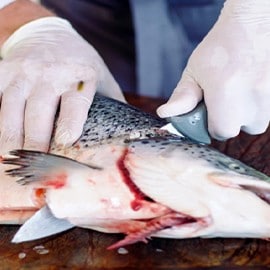

Tip 1: Delivery Temperature
When fresh produce is delivered, measure the temperature of each ingredient. If the temperature is not correctly chilled, bacteria can grow faster. Call your delivery partner and return the produce.

Tip 2: Toxic Chemicals
Keep toxic chemicals and cleaning products away from food. Never put hazardous substances above food.

Tip 3: Floor Level
Do not store boxes on the floor, but on a raised platform or shelf. The floor is a source of bacteria.

Tip 4: Storage Space
Make sure the storage space and products are clean and hygienic. You should be able to close the storage area to keep it dry and safe from pests.

Tip 5: FIFO
When storing and stocking products, you should use the First In, First Out (FIFO) system. By using this method, you’ll ensure both food quality and food safety. The FIFO method ensures that when a restaurant gets food delivered, the food will be stored behind the deliveries. This method ensures that the older food will be used first.

Tip 6: Labelling
When food is prepared, remember to add preparation date to dish. (add stickers here: date, dish name, date of prep).

Tip 7: Meat goes under
Meat should always be stored beneath other food items to prevent cross contamination, of the meat juices, with other food items.

Tip 8: Stick to Temperatures
Follow the Food Storage temperature regulations to ensure your food is always stored at optimal temperature to ensure freshness and prevent food contamination.
Restaurant Food Storage Chart
-
FOOD CATEGORY
RECOMMENDED STORAGE TEMPERATURE
Perishable Food in the freezer such as meat
-18 C°
Perishable Food in Refrigeration such as fish and meat
0 - 7C°
Dry Foods such as Rice or Pasta
16 - 21C°
Perishable Food in Refrigeration such as fruits and vegetables
2 - 7C°
Perishable Food in Refrigeration such as Dairy
2 - 7C°
